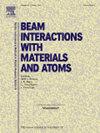The influence of Fe substrate crystallographic orientation on the film formation of Cu clusters
IF 1.4
3区 物理与天体物理
Q3 INSTRUMENTS & INSTRUMENTATION
Nuclear Instruments & Methods in Physics Research Section B-beam Interactions With Materials and Atoms
Pub Date : 2025-04-15
DOI:10.1016/j.nimb.2025.165691
引用次数: 0
Abstract
In this study, molecular dynamics simulations were conducted to investigate the continuous deposition of Cu13 clusters on Fe(001), Fe(011), and Fe(111) substrates, analyzing the effects of substrate crystallographic orientation on film formation. The results demonstrate that the crystallographic orientation of the Fe substrate has a significant impact on the film properties, including morphology, layer coverage, interfacial mixing, epitaxial quality, and internal stress. Furthermore, the influence of crystallographic orientation on the film evolves with increasing incident energy. At lower incident energies, films on the Fe(001) substrate exhibit the lowest surface roughness, while at higher incident energies, films on the Fe(011) substrate are the smoothest. Across the entire range of incident energies, films grown on the Fe(001) substrate have the highest epitaxial quality and layer coverage, whereas those on the Fe(011) substrate show the lowest interfacial mixing.
Fe衬底晶体取向对Cu簇成膜的影响
本研究通过分子动力学模拟研究了 Cu13 团簇在铁(001)、铁(011)和铁(111)基底上的连续沉积,分析了基底晶体取向对薄膜形成的影响。结果表明,铁基底的结晶取向对薄膜的形态、层覆盖率、界面混合、外延质量和内应力等特性有显著影响。此外,晶体取向对薄膜的影响随着入射能量的增加而变化。入射能量较低时,铁(001)基底上的薄膜表面粗糙度最低,而入射能量较高时,铁(011)基底上的薄膜表面最光滑。在整个入射能量范围内,在铁(001)基底上生长的薄膜具有最高的外延质量和层覆盖率,而在铁(011)基底上生长的薄膜则显示出最低的界面混合。
本文章由计算机程序翻译,如有差异,请以英文原文为准。
求助全文
约1分钟内获得全文
求助全文
来源期刊
CiteScore
2.80
自引率
7.70%
发文量
231
审稿时长
1.9 months
期刊介绍:
Section B of Nuclear Instruments and Methods in Physics Research covers all aspects of the interaction of energetic beams with atoms, molecules and aggregate forms of matter. This includes ion beam analysis and ion beam modification of materials as well as basic data of importance for these studies. Topics of general interest include: atomic collisions in solids, particle channelling, all aspects of collision cascades, the modification of materials by energetic beams, ion implantation, irradiation - induced changes in materials, the physics and chemistry of beam interactions and the analysis of materials by all forms of energetic radiation. Modification by ion, laser and electron beams for the study of electronic materials, metals, ceramics, insulators, polymers and other important and new materials systems are included. Related studies, such as the application of ion beam analysis to biological, archaeological and geological samples as well as applications to solve problems in planetary science are also welcome. Energetic beams of interest include atomic and molecular ions, neutrons, positrons and muons, plasmas directed at surfaces, electron and photon beams, including laser treated surfaces and studies of solids by photon radiation from rotating anodes, synchrotrons, etc. In addition, the interaction between various forms of radiation and radiation-induced deposition processes are relevant.

 求助内容:
求助内容: 应助结果提醒方式:
应助结果提醒方式:


